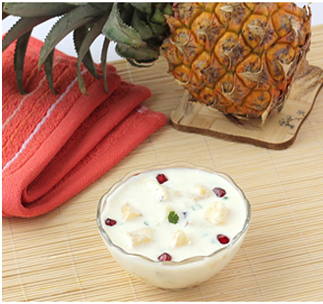Pineapple
-
COSTACHE RAREȘ-MIHAI
-
Clasa a 12-a B
-
Colegiul Național “Mircea cel Bătrân”
General details
Ananas comosus, the pineapple, is part of Bromeliaceae family and it is one of the America’s favourite tropical fruit, being second only to bananas; the pineapple has a distinctive appearance. It is, in fact, a collection of multiple fruitlets, each one of individual blossom, which fuse together around a central core. The sepals become fleshy and develop into the well-known form pseudocarpfruit, crowned by a rosette of leaves .Each of them can be identified by an “eye”, giving the brownish skin the scaly aspect. .The pulp in the ripe pineapples has a vibrant tropical flavor and its color may vary from white to yellow. The pineapple notoriety was given by its taste and rarity. Native from Mesoamerica, pineapples can now be commonly found in any grocery store.
They grow in the tropical part of South America all the way to Argentina. Moreover, anyone can grow their own pineapple in their houses in a flower pot. All you need to do is plant the leafy cap, water it lightly once a week, keep it away from cold weather and make sure it has enough light.
PINEAPPLE IN HISTORY
In 1493, on his second voyage to the Caribbean region, Christopher Columbus saw, ate and enjoyed the curious new fruit which had a segmented exterior like a pine cone and an interior like an apple. The locals called the pineapple “nana” or “anana” which means “excellent fruit” He brought pineapples to Europe where the fruit became an item of celebrity and curiosity. The fruit later became the symbol of hospitality. Hostess who honored its guests with pineapple-topped food displayed no budget restriction to ensure their dining pleasure. The sense of welcome and good cheer was soon to be associated to the image of pineapple, becoming an artistic motif.
CHEMICAL COMPOSITION
Raw pineapples are source of vitamins and minerals such as vitamin A, B, B1, B2, B5, B6, B9, C, manganese, potassium, calcium, phosphorus, iron, magnesium and antioxidants. One hundred grams of pineapple contain 50 kcal, 0.1g fats, 13g carbohydrates, 0.5g of proteins, and 80g water. It is an excellent source of vitamin C (47.8mg/100g) and manganese (0.9mg/100g), representing 46% of the recommended daily value (DV). It also contains a mixture of substances called bromelain which has a wide variety of health benefits, from helping the digestive system to treating muscular degeneration. Fresh pineapple is the only source of bromelain.
Bromelain is the most valuable compound in pineapple. The pineapple juice eases the protein digestion, being able to replace the gastric juice, bromelain being comparable with pepsin. For this reason, pineapple is a recommended desert and, for the same reason, it is also used as meat tenderizer. Moreover, bromelain is an anti-inflammatory agent which can be used in treating post-surgical swelling or even in treating arthritis.
MEDICAL USE
Pineapples’ properties are being used for centuries to induce menstruation, induce abortion, kill parasitic amoebas, and expel worms. They are used to treat digestive problems and inflammation. Many studies show that pineapple consumption decreases the risk of obesity and overall mortality, diabetes and heart disease due to the amount of antioxidants, bromelain and potassium. The intake of vitamin A and C from pineapples helps maintain healthy hair, skin and nails. Specialists recommend pineapple in low-carbs diets and in diabetics’ diet.
HOW TO CONSUME
There are some aspects that should be taken into account when selecting a pineapple.  The fruit should not have any bruising or soft spots. Contrary to popular belief, a green outer shell does not mean the pineapple is not ripe. Unlike other fruits, once picked, the pineapple will not continue to ripen. For this reason, the pineapple must be picked only when it is ripe.
The fruit should not have any bruising or soft spots. Contrary to popular belief, a green outer shell does not mean the pineapple is not ripe. Unlike other fruits, once picked, the pineapple will not continue to ripen. For this reason, the pineapple must be picked only when it is ripe.
There are different techniques of slicing a pineapple. One of them is to chop the crown, then to slice it like a watermelon: put the pineapple vertically and slice it from top to bottom in 4 or 6 equal parts; peel them and remove the core. Another technique is peeling the pineapple right after the crown chopping. However, there is a slightly bigger chance for the “eyes” to remain and create a little visual and taste discomfort. After cutting, you can store it for about 6 days. Fruits retain many of its nutriments up to 6 days if chilled.
Pineapples can be used in different recipes.
One of them is ‘Pineapple Raita’
What you need is:
-
pineapple chopped – 1 cup
-
yogurt whisked – 1 cup
-
sugar – 1 teaspoon
-
salt to taste
-
roasted and powdered cumin seeds – 1 teaspoon
-
fresh coriander leaves chopped – 1 tablespoon
To start with, take yogurt, sugar, powdered cumin seeds and salt in a bowl. Stir well with a whisk until smooth and then stir in diced pineapple. Transfer yogurt mixture into a serving dish, and chill. Right before serving, sprinkle with chopped coriander leaves.
PERSONAL EXPERIENCE
My name is Costache Rares Mihai and I study at “Mircea cel Bătrân” National College. I am in the 12th grade and a future medical student. Pineapple was my choice because when I was younger, I used to eat a lot of it. It so happened once that I fell asleep while eating pineapple. I fell asleep with a tiny piece of pineapple in my mouth. When I woke up, I noticed that the tiny piece left a not so deep hole on the inside of my cheek. For the first time I was aware that the pineapple could “eat” you too.







